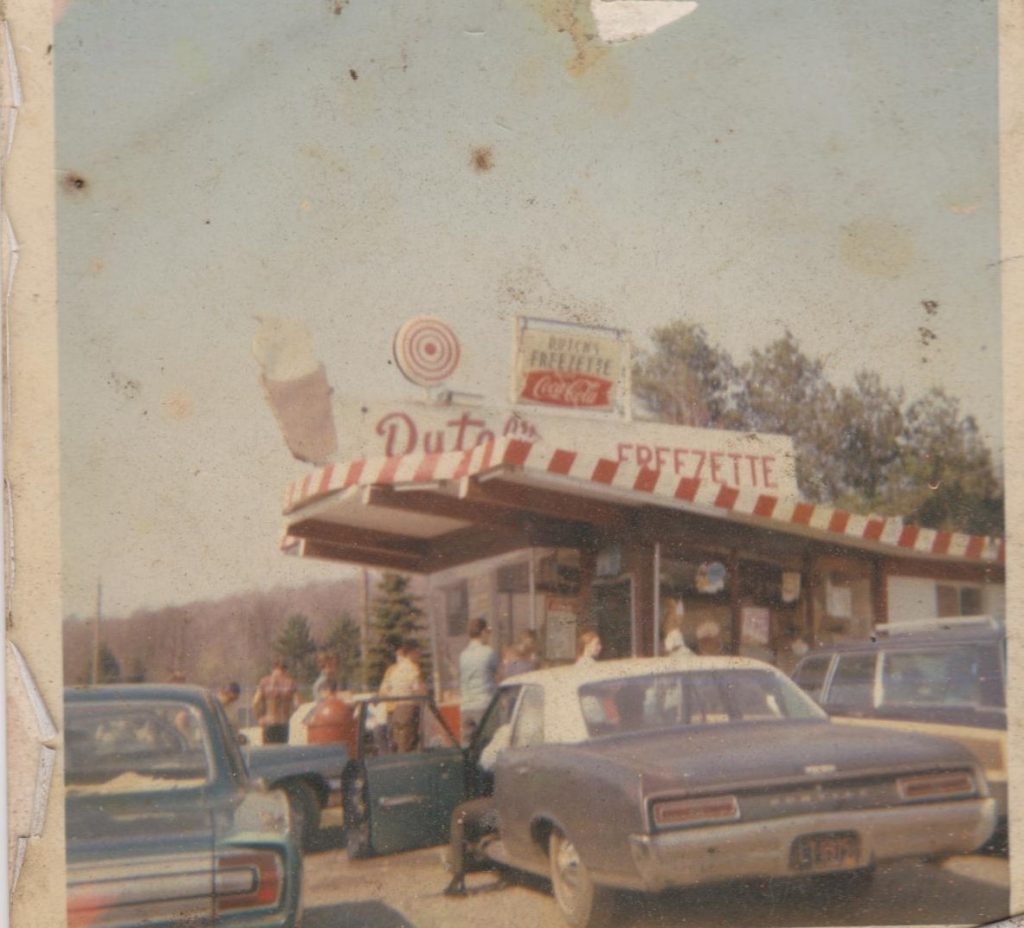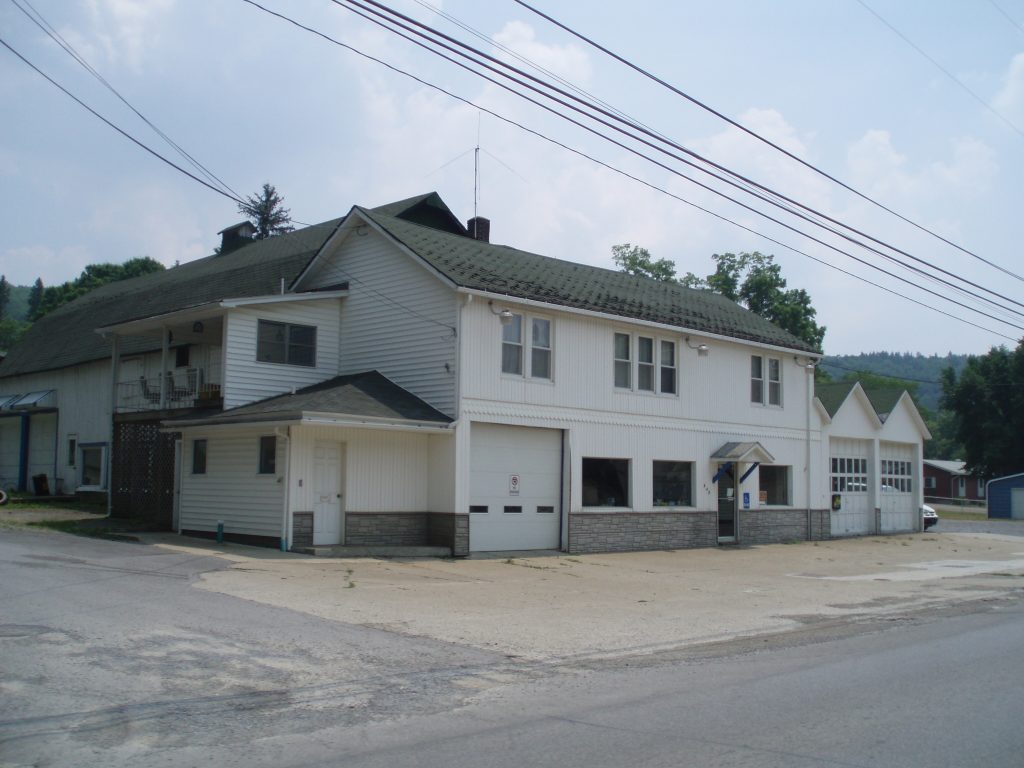Sometime abound 1831 William P. Wilcox,, who worked as the land agent for the Richard & Jones Land Company, settled near the the Elk / McKean County line along the turnpike to Smethport in an area known as Williamsville.
Other settlers also began to build homes in the Township along the Milesburg / Smethport Turnpike (current day Mefferts Run Road and the Rasselas Road). Others deciding to build near the flat soil rich bottom land along the West Branch of the Clarion River. These hard-working men & women also began cutting the large stands of eastern hemlock. The small developing village was referred to as Buena Vista by the inhabitants, which means beautiful view. Surely these early settlers must have taken great pride and affection to their new home town to give it such a befitting name. One of these settlers was Alonzo I. Wilcox, son of William P. Wilcox.
In 1849 Alonzo Wilcox purchased about 800-acres from Andrew Jones in what today is the Village of Wilcox. Mr. Wilcox soon built a rather crude water powered sawmill near what was then called the Big Toby Creek (today known as the West Branch of the Clarion)
By 1850, the young settled area harbored forty-five dwelling amounting to 337 inhabitants. The surrounding Jones Township supported twenty-three farms and one small industry (a lumber mill). The population in 1880 grew to 1,427. In 1888 there were 218 Republican, 125 Democratic and 3 Prohibitionist votes cast, representing about 1,740 inhabitants. A large number of unnaturalized Swedes, and other foreign residents, swelled the total considerably.

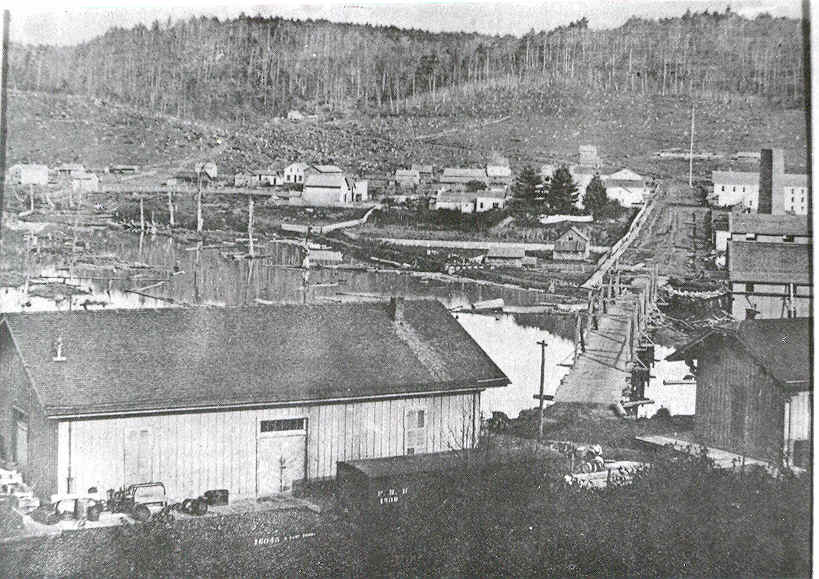

It was in 1858 that the settlement was formally recognized as a town and given the name of “Wilcox” in honor of Alonzo Wilcox and the Wilcox family. Just prior to this time, the young Alonzo Wilcox went into the lumber industry and owned and operated a sawmill along the river. He also built a rather impressive home for his family. This building still stands today and is now the home for the American Legion.

Then, in 1864 when Theodore Palen and other investors from New York State purchased 10 acres of land from Alonzo Wilcox along the West Branch of the Clarion River. Intending to expand the family’s tanning and leather business, Palen also secured the rights to hemlock bark on another 1500 acres in Jones Township. About 1866 Mr. Jackson Schultz had convinced his brother Maurice M. Schultz to partner and later purchased the Palen family interests in Jones Township. The Schultz family already had other tannery interests throughout the area and wanted to expand their operations. The site in Wilcox, with the new railroad having just been constructed, offered them the opportunity to expand their business endeavors.

Although the lumbering business prospered for many years in Jones Township, it was in 1866, two years after the Philadelphia & Erie Railroad was completed, that would bring long term prosperity to the village of Wilcox. It was then that Maurice M. Schultz managed the Wilcox Tanning Company along the West Branch of the Clarion river and railroad. Many tannery’s were constructed throughout the region in locations such as Instanter, Johnsonburg, Emporium, Ridgway and St. Marys just to name a few. However the Wilcox Tannery was by far considered the largest, perhaps in the world. It was at one time reported that investors in the Wilcox tannery offered over one million dollars in capital to finance the project.
Buffalo hides initially served a very large proportion of the early tanning activity by the Wilcox Tanning Company. Buffalo hides from the plain states and later cow hides from the large cattle yards of Chicago were shipped to Wilcox by railroad. It is an unfortunate footnote to this story that Wilcox prospered quite well from the extermination of the American buffalo.
Initially the Tannery cut hemlock and employed bark peelers to strip the bark from the tree – leaving the remaining tree to waste. The bark was transported by wagon, skids and eventually by railroad back to the tannery. Later, sawmills began to appear in the area utilizing the hemlock as building material.
At its peak, the tannery is said to have employed up to 300 men an additional 400 men to peel bark from the hemlock. As part of the tanning process hemlock bark was required in great quantities. The bark contains valuable chemicals, such as tannin, used to tan the hides. Near the turn of the century, the Wilcox Lumber Company and the Wilcox Tannery worked together to supply bark.
When the Wilcox lumber mill could not keep up with the tannery’s demand for hemlock bark, other operations were contracted to supply the needed bark, one near Burning Well. When the hemlock back was no longer available, nuts from South & Central America were shipped in to tan the hides.
The lumber companies in the region would provide the 25,000 cords of hemlock bark that the tannery required to process the nearly 333,000 buffalo hides processed at the facility annually. The plant had 13 boilers powered by gas wells located at the site. 732 vats, seven (7) feet wide, nine (9) feet long and five and a half (5 1/2) feet deep were encompassed within the facility, making it the largest leather tanning facility in the world.
The company constructed a 36-inch broad gauge railroads throughout the Township in order to provide the valuable hemlock bark. Entire mountain sides were totally denuded of trees to fuel this demand for hemlock. At one time the Tannery owned 44,000-acres of forest land in Elk & McKean County.

By the start of World War 2, The Wilcox Tannery had liquidated the greater part of it’s property holdings in Jones Township. When the Elk Tanning Company was organized, the Wilcox Tannery was merged into the new company, which operated most all of the still existing tanneries in Elk County. One goal of the new company was to liquidate it’s vast holdings of land that was now stripped of it’s valuable timber and now useless to the company. It also sold off several blocks of buildings and a number of it’s company owned houses in Wilcox.
The hamlet of Wilcox had a population of about 1200 in 1890. The town even had it’s own medical doctor, Dr. J.H. Wells from New York to care for the young community. Many workers lived in cozy two-story company owned homes along what was nicknamed “tannery row”. These company homes were provided with a tool shed and an outhouse. A handsome residence was provided to the superintendents, A. A. Clearwater and Robert Manett who lived on elevated ground overlooking the 100- plus acres occupied by the company. The operations at the tannery provided the village with both gas and electric power. The Tannery also constructed the required infrastructure required to support it’s operations.

By the 1950’s, new methods of producing leather, lower demand for leather and the decline of the hemlock bark resulted in many of the local tanneries closing. The Wilcox Tannery however survived a while longer and suffered a slow death. The Wilcox Tannery, later owned by Albert Goldman Company, had been struggling for several years, and eventually ceased operations in 1962. At that time the plant was stripped of all valuable equipment. The entire facility was later destroyed by fire in 1966.(Click here for the story) The site was later turned over the Wilcox Area Development Authority which has led to light industrial development of the former tannery site. It is ironic that the only remains existing today of this once famous industrial giant are a few foundation piers and the concrete foundation for the tannery’s sludge (sewage) filtering plant.

There were many other industrial and commercial operations in Wilcox at the turn of the century. The cheap and abundant supply of recently discovered natural gas reserves and sand that was low in iron content, necessary for glass making, lured many business entrepreneurs.
In 1910, the Wilcox Glass Bottle Company began operations and was situated where the current electric power sub-station is located near the Township Park & Ballfield. The plant employed 48 skilled hand-blowers and over 100 laborers until the factory destroyed by fire in 1927- never to be rebuilt . Another glass manufacture was the George Window Glass Company (located where the Jones Township Road Dept. is located on the Old Kane Road today) that was built in 1899 and covered over 2-acres of land. The factory ceased operations in 1916 and the building was also eventually destroyed by fire. A third window glass plant (Van Cleve) was located just north of the George Window Company and operated only a few years.

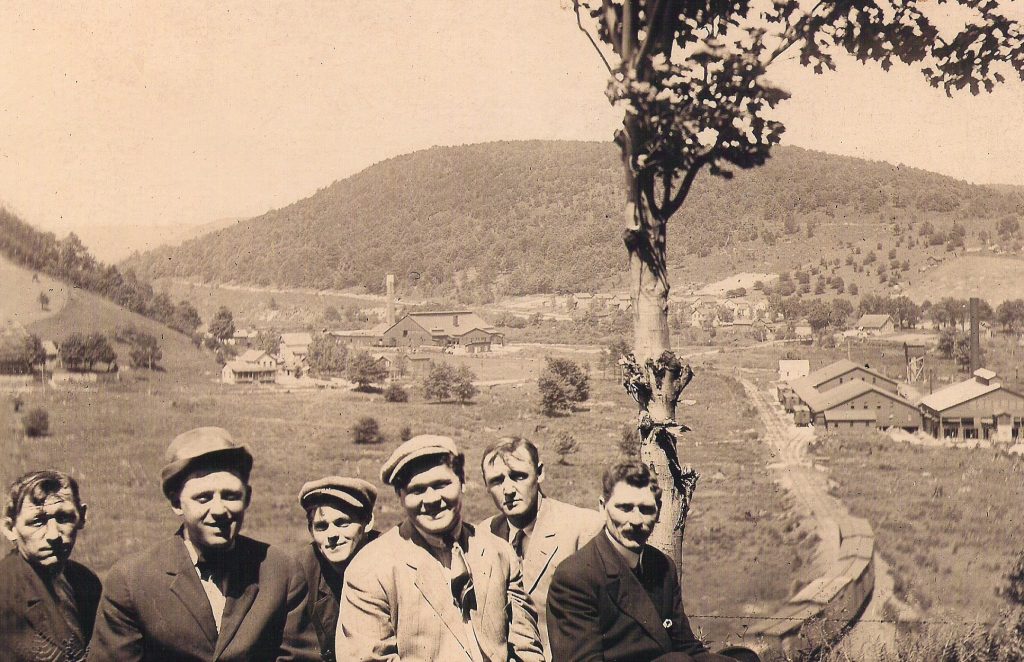

The Pioneer Store (later the Smith Bros and then the Town & Country store) was build and operated by Mr. Wilcox and his cousin Lucius Wilcox until 1861 when it was sold to A.T. Aldrich. As was common, it too was destroyed by fire, then rebuilt and named the Tanning & Lumber Company Store, until purchased by the Smith Brothers from Ridgway. This new store was a full service department store employing as many as 20 people. Smith Bros operated several of these small, local department stores through the region. This building still stands and in now owned & occupied by Peterson Studios.

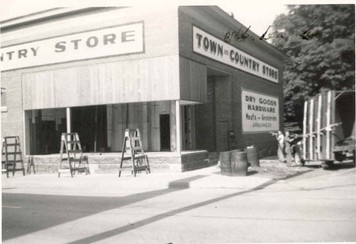


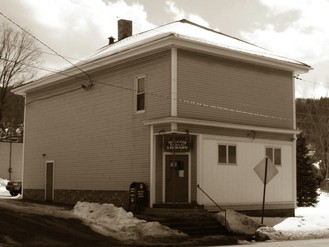
Many fine hotels and inns existed in the Wilcox area including the Grant House originally constructed by R. Brennen, and the McFarland House. However the grandest of all was by far the Wilcox House and Hotel (below) which too was later destroyed by fire in 1982 and sat in what is now a car lot owned by the Wilcox Garage.






As the community of Wilcox grew, so did it’s need to educate it’s children. The first known Jones Township school was established in 1842 when Peter Hardy taught in a little frame building erected about that time at the crossing of the turnpike (Rasselas Road) and the St. Mary’s Road, in Jones Township.
Ebenezer Lee, J. Montgomery, John W. Blake, Jacob Meffert, Ira Westcott and Rasselas. W. Brown, were the first elected school directors in 1844. At the time there were a number of school houses erected in the Township.
On October 12, 1872, The Directors purchased a one-acre parcel of land from the Wilcox Land and Mining Company on Faries Street along the road to Rasselas to construct a large school building .
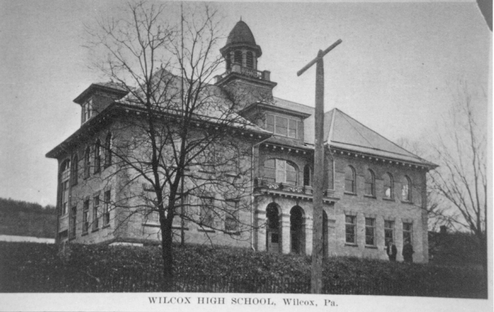
A new school, a handsome two story brick structure, was constructed at the same site as the destroyed school. The new school was ready for opening day of school in September 1917. At this time, children from the eastern parts of Jones Township were transported to attend class in this new building.

In 1935 The Jones Twp. School District purchased another acre of land directly behind the existing school from Henry & Nancy Wining. Then, in 1936 the School Directors constructed an additional building behind the two-story school. This new brick building would be utilized as the High School, while the younger kids would attend class in the older structure. This new building provided a gymnasium, and enough room to accommodate the additional students.
The older two-story school building (shown above) was eventually torn down because of safety issues in the early 1970’s. It was around this time that the state consolidated the local school districts in to larger regional school districts. All of the schools in Wilcox now would be under the authority of the Johnsonburg Area School District.
Classes continued in Wilcox until 1971. From then on, all children attended classes in Johnsonburg once the new Elementary School was build along Route 219 in Ridgway Township. The school buildings and grounds were turned over the Jones Township Board of Supervisors in October 1974 with the expressed purpose of a community center.

By the time of the end Great Depression of the 1930’s the growing town now had 20 street lights and crudely paved streets. However often times the Township Road District would not have enough money to pay it’s employees, lending itself to borrow money from local residents to meet it’s obligations. In December of 1935, the Township took out a note for $500.00 from Gretchen Hetznecker to meet the payroll and to purchase it’s first snow plow for the Township’s 1930 Model Chevrolet truck in order to keep the streets and Township roads open during the winter. This truck was soon traded in for a newer 3- ton 1936 Model Chevrolet with dual wheels which was needed to plow the snow.




It was in August of 1936 that the Wilcox Fire Department was formally recognized at the official company affording the village with fire protection.

Shortly after the Second World War, many improvements were made in Wilcox. Much of the original infrastructure installed by the Wilcox Tannery to serve it’s interests in the village were beginning severely age and in dire need of repairs. By this time work at the Tannery began it’s decline and suffering it’s slow death. As such, it wasn’t too concerned about repairing these facilities. The Township Supervisors were receiving complaints on a monthly basis of raw sewage on the streets and ponding in yards from broken water and sewer lines.
In August of 1950, the citizens of Wilcox petitioned the Township to take over and repair the the aging collection of sewers. Immediately the old collection of tile and clay sewer pipes was taken over and was now under the control of the Township Supervisors which then required a connection to each dwelling in the service district and began to collect fees to repair the aging system.. Then, in May of 1952 work began of installing a new sewer and drainage system. By March of 1954, the new sewers and drainage system were completed and all homes were ordered to connect to the system which discharged the untreated sewage directly into the West Branch of the Clarion River.
This sewer and drainage system served the community up until about 1980 when the Pennsylvania Dept. of Environmental Resources ordered action to be taken to stop the discharge of the untreated sewage into the river. This then resulted in the construction of a modern sewer collection system in 1999. With this new collection system, sewage was transported by a pressurized pipeline to the sewage treatment plant 6 miles south to the Johnsonburg Wastewater Treatment Plant.
In 1956 the aged and privately held Wilcox Water Company, which also needed repairs, was purchased by the Johnson family. The Johnson’s made the necessary improvements to provide a good, potable water supply to the community by running new water lines and dug a new water well to supplement the reservoir. Several citizens of the time had also wanted the Township to also take over the water company. However, since no petition was presented by the community, the Township refused to purchase the water company. However, in later years, the Jones Township Municipally Auth. did purchase the Wilcox Water Company and implemented many needed improvements.
The early 1950’s also saw much needed transportation improvements in the area. The new State Route 219 (which was at one time called Route 97) was being constructed through town. Up until now, Route 219 traversed from Johnsonburg through Wilcox to Kane on was what is now known as the Old Kane Road and State Route 321. These improvements led the new and modern highway (Route 219) along Marvin Street and directly up the valley to Lantz Corners.
Road Construction near the Smith Gas Station on Marvin Street (Route 219) The image on the left shows the intersection of Oak & Marvin Streets.
The construction of the modern highway through Wilcox then led to a number of other problems presented to the town. Route 219 was then the major north / south route through central Pennsylvania. A major problem facing the community became motorists speeding on the new highway. The Jones Township Road District then requested that the State Highway Department install a traffic light at the Route 219 (Marvin Street) and Clarion Street intersection. Also considered in 1954 was allowing the Fire Department install a speed trap to catch the speeding motorists. It was later learned that this would not be feasible so it was once considered that Johnsonburg Special Police could use their speed trap. This was also ruled as not to be lawful.
Then, at the October 29, 1954 meeting of the Township Supervisors, a petition was presented from 35 residents to request the Township install it’s own police department. At this meeting the Township established the Jones Township Police Department. Charles Hart was named as Chief, with the power to hire and fire police for the Township. Charles Dietrick, Philip Hoh, Arthur R. Airgood, and Kenneth Launer were administered an Oath and sworn as officers. The policemen were paid $1.00 per hour and $1.00 per month for use of their vehicles. The first item ordered for the dept. was a stopwatch, a flashlight, and a speed trap device. Approval was also given to spend up to $100.00 for office equipment.
Two months later, Jerome Jones, Ronald Launer, John Wantuck, Carl Whippo, Jones Shuey, Paul D. Anderson, Wallace Thayer, Lawrence Parks, Edward Hanson. were also sworn is as officers.

Photo Credit: 1989 Tina Ritter
In 1955 is was reported that the Police Dept. collected $5655.00 in fines from the speed trap with an average violator caught in the trap of 31 per month. The following year a petition of well over a hundred persons was offered to the township Supervisors to reduce the size of the police force.


